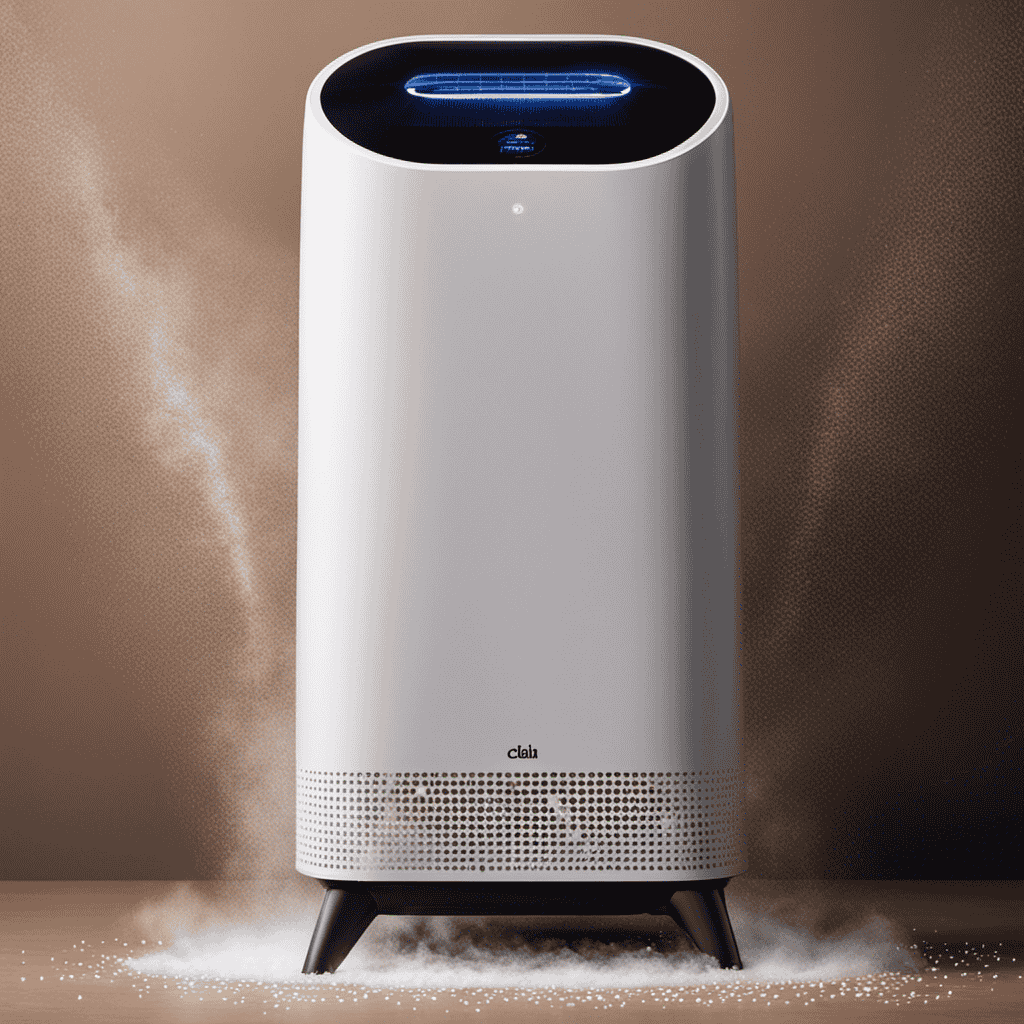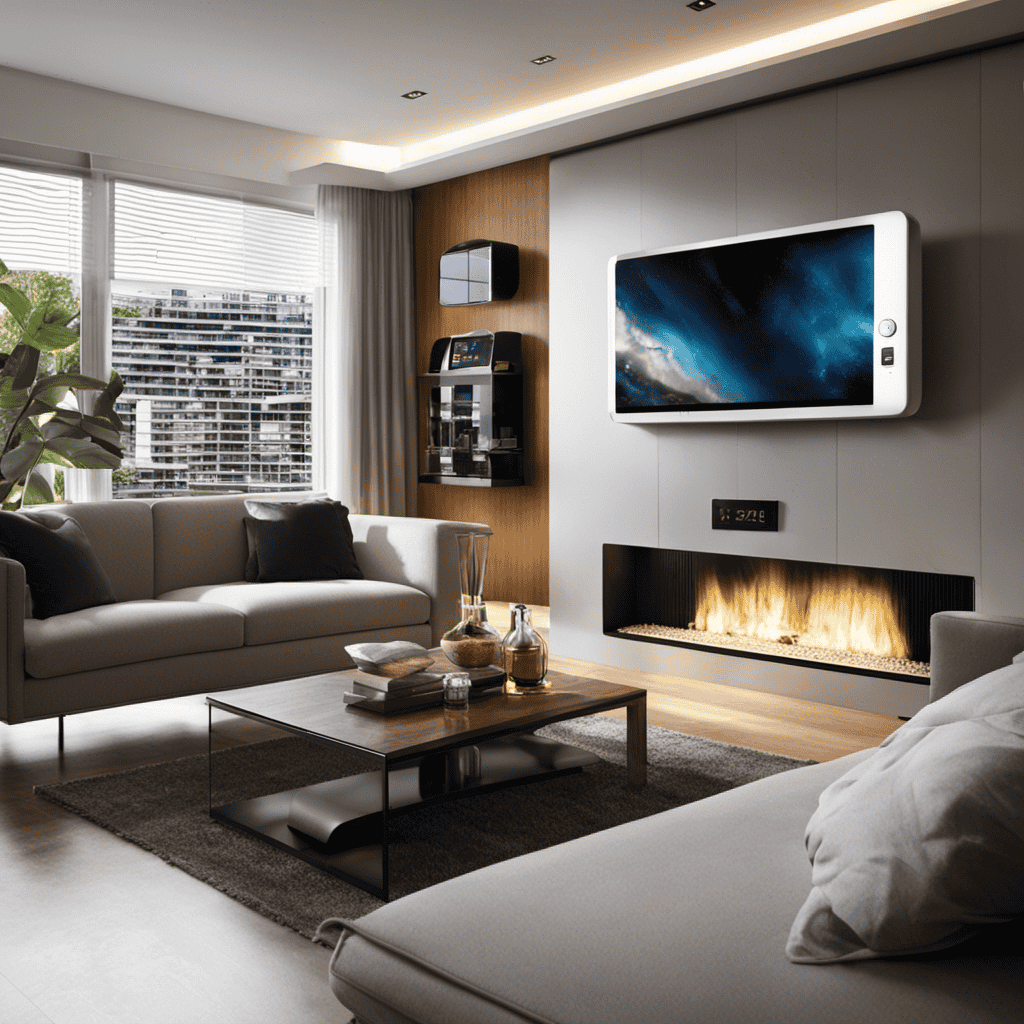Hey there! Have you ever thought about how frequently you should clean your air purifier? Don’t worry, I can help you with that.
In this article, I’ll walk you through the signs that indicate your air purifier needs cleaning, the importance of regular maintenance, and the factors that determine the cleaning frequency.
Plus, I’ll provide you with a step-by-step guide on how to clean different types of air purifiers and share some common mistakes to avoid.
So, let’s dive in and keep our air purifiers squeaky clean for fresher, healthier air!
Key Takeaways
- Regular maintenance is crucial for optimal performance of an air purifier.
- The frequency of cleaning an air purifier depends on factors such as usage, environment, and type/quality of the filter.
- The cleaning process involves turning off and unplugging the device, cleaning or replacing the filters, wiping the exterior with a damp cloth, and testing the device after cleaning.
- Efficient cleaning tips include vacuuming the exterior, tapping the filter to dislodge loose particles, cleaning the pre-filter with a soft brush or cloth, and regularly checking and replacing the filter as needed.
Signs That Your Air Purifier Needs Cleaning
If you notice a decrease in air quality or an increase in dust and allergens, it’s a sign that your air purifier needs cleaning. Regular maintenance is crucial to ensure its optimal performance.
Factors to consider when choosing an air purifier include the type of filtration system, room size, and specific needs such as removing pet dander or odors.
Signs of a malfunctioning air purifier can include strange noises, a decrease in airflow, or a failure to remove pollutants effectively.
Cleaning your air purifier involves several steps. First, turn off and unplug the unit. Then, remove the filter and gently vacuum or wash it, depending on the type. Wipe down the exterior with a damp cloth and clean any vents or grilles. Reassemble the unit and perform a test run to ensure it is working properly.
Regular cleaning and maintenance will help your air purifier continue to provide clean and healthy air for your home.
The Importance of Regular Maintenance for Air Purifiers
Regular maintenance is important for keeping your air purifier functioning effectively. Taking care of your air purifier not only extends its lifespan but also ensures that it continues to provide clean and fresh air.
Here are some benefits of regular maintenance and some recommendations for a cleaning schedule:
-
Improved air quality: Regularly cleaning or replacing the filters in your air purifier helps remove dust, pollen, pet dander, and other airborne particles, improving the overall air quality in your home.
-
Enhanced performance: When filters are clogged with dirt and debris, your air purifier may struggle to effectively clean the air. Regular maintenance ensures that your purifier operates at its optimal level, providing you with better results.
-
Cost savings: By maintaining your air purifier, you can prevent major breakdowns and costly repairs. Regular cleaning and maintenance help keep your purifier in good working condition, saving you money in the long run.
-
Health benefits: A clean air purifier means cleaner air, which can have positive effects on your health. Regular maintenance helps reduce the risk of respiratory issues, allergies, and other health problems caused by poor indoor air quality.
To keep your air purifier in top shape, it is recommended to clean or replace the filters every 3-6 months, depending on the manufacturer’s instructions. Additionally, regular dusting and wiping of the exterior and vents can help maintain its performance.
Factors That Determine the Cleaning Frequency of Air Purifiers
When it comes to determining the cleaning frequency of air purifiers, there are several key factors to consider.
First, the usage and environment in which the air purifier is placed plays a crucial role. A high-traffic area or a location with heavy pollution will require more frequent cleaning compared to a low-traffic area with cleaner air.
Secondly, the type of filter used in the air purifier is important. Different filters have varying levels of efficiency and lifespan, which will impact how often they need to be cleaned or replaced.
Lastly, the quality of the filter also plays a significant role. Higher quality filters tend to have better filtration capabilities and may require less frequent cleaning.
Usage and Environment
To ensure optimal performance, make sure you’re placing your air purifier in a well-ventilated area. This will allow the purifier to effectively circulate and filter the air in the room.
In addition to proper placement, regular maintenance and cleaning are essential for the air purifier to function efficiently. Follow a cleaning schedule to keep your air purifier in top condition. Here are some key points to consider:
-
Frequency: The cleaning frequency will depend on the usage and environment. If you use your air purifier in a highly polluted area or if you have pets, you may need to clean it more often.
-
Filters: Check the manufacturer’s instructions to determine how often to clean or replace the filters. Typically, pre-filters should be cleaned every 1-3 months, while HEPA filters should be replaced every 6-12 months.
-
Exterior: Wipe down the exterior of the air purifier regularly with a damp cloth to remove dust and dirt.
-
Professional servicing: Consider having your air purifier professionally serviced annually to ensure it is working at its best.
Filter Type and Quality
Make sure you’re aware of the filter type and quality when choosing an air purifier. The maintenance and performance of an air purifier heavily rely on the filter.
There are different types of filters available in the market, each with its own unique features and capabilities. The most common types include HEPA filters, activated carbon filters, and ionizers.
HEPA filters are highly efficient in capturing small particles like dust, pollen, and pet dander. Activated carbon filters are effective in removing odors and chemicals from the air. Ionizers use charged particles to attract and remove pollutants.
When choosing the right filter for your air purifier, consider the specific needs of your environment and the air quality concerns you want to address.
Regular filter replacement and cleaning are essential for maintaining the performance of your air purifier and ensuring clean and fresh indoor air.
Step-By-Step Guide to Cleaning Your Air Purifier
Cleaning your air purifier is crucial for its performance and efficiency. Regular cleaning helps prolong the lifespan of your device and ensures a clean indoor environment. In this discussion, we will explore the significance of cleaning frequency, the step-by-step process of cleaning, and valuable tips for efficient cleaning. By understanding the importance of regular cleaning and following proper procedures, you can maintain a healthy environment.
Cleaning frequency is essential for air purifiers. Regular cleaning prevents the accumulation of dust, dirt, and other particles that can clog the filters and reduce the device’s effectiveness. The frequency of cleaning depends on various factors, such as the air quality in your area and the usage of the air purifier. It is recommended to clean the filters every three to six months, but you may need to clean them more frequently if you live in a highly polluted area or use the device extensively.
To clean your air purifier, follow these step-by-step instructions. First, turn off and unplug the device. Remove the filters according to the manufacturer’s instructions. Use a soft brush or vacuum cleaner to remove dust and debris from the filters. If the filters are washable, rinse them with water and let them dry completely before reinstalling. For non-washable filters, replace them with new ones. Wipe the exterior of the device with a damp cloth to remove any dirt or grime. Finally, plug in and turn on the air purifier.
Here are some valuable tips for efficient cleaning that will help prolong the lifespan of your air purifier. Regularly vacuum the area around the device to prevent dust from accumulating. Keep the air purifier away from sources of dirt or pollutants, such as open windows or smoking areas. Follow the manufacturer’s instructions for filter replacement or cleaning. Consider using a pre-filter to capture larger particles and extend the life of the main filter. By following these tips, you can ensure that your air purifier functions optimally and provides clean air for your indoor environment.
Cleaning Frequency Importance
Regularly cleaning your air purifier is important for maintaining its effectiveness. Many people have misconceptions about the frequency of cleaning their air purifiers. Here are some important points to consider:
-
Follow the manufacturer’s guidelines: Each air purifier model may have different cleaning recommendations, so it’s crucial to consult the instruction manual for specific instructions.
-
Monitor the air quality: Pay attention to the air quality in your surroundings. If you live in a highly polluted area or have pets, you may need to clean your air purifier more frequently.
-
Visual inspection: Regularly inspect the filters and the overall condition of your air purifier. If you notice a buildup of dirt or dust, it’s time for a cleaning.
-
Regular maintenance schedule: Establishing a routine maintenance schedule will ensure that you don’t forget to clean your air purifier. Set reminders or mark it on your calendar.
Cleaning Process Explained
It’s important to understand the steps involved in the cleaning process of your air purifier. Proper maintenance will ensure that your air purifier is functioning effectively and providing you with clean, fresh air.
To begin the cleaning process, make sure to unplug the unit and remove the filter. Most air purifiers have a washable filter, but some may require replacement. If the filter is washable, rinse it under running water and use a mild detergent to remove any built-up dirt or debris. Allow the filter to air dry completely before reinserting it into the unit.
Additionally, it’s a good idea to wipe down the exterior of the air purifier with a damp cloth to remove any dust or grime. Remember to follow the manufacturer’s instructions for cleaning techniques and best practices to maintain the efficiency of your air purifier.
Tips for Efficient Cleaning
To keep your air purifier working efficiently, make sure to regularly check and replace the filter as needed. Cleaning techniques and a proper cleaning schedule are essential for maintaining the effectiveness of your air purifier.
Here are four tips to help you clean your air purifier efficiently:
-
Vacuum the exterior of the unit to remove any dust or debris that may have accumulated on the surface.
-
Remove the filter and gently tap it to dislodge any loose particles. Depending on your air quality, you may need to clean or replace the filter every 3 to 6 months.
-
Use a soft brush or cloth to clean the pre-filter, which helps trap larger particles before they reach the main filter.
-
Wipe down the housing and vents of the air purifier with a damp cloth to remove any remaining dirt or dust.
Common Mistakes to Avoid When Cleaning Your Air Purifier
One common mistake to avoid when cleaning your air purifier is forgetting to unplug it from the power source before starting the cleaning process. This is important because it ensures your safety and prevents any potential damage to the device.
Additionally, it is crucial to follow proper cleaning techniques to maintain the efficiency and longevity of your air purifier. Firstly, make sure to refer to the manufacturer’s instructions for specific cleaning instructions.
Generally, you should start by removing the filter and gently vacuuming or washing it, depending on the type. Next, wipe down the exterior of the purifier with a damp cloth. Avoid using harsh chemicals or abrasive materials that could damage the device.
How to Clean Different Types of Air Purifiers
When it comes to cleaning different types of air purifiers, it is important to use the right cleaning techniques and supplies. Here are some tips to help you clean your air purifier effectively:
-
Unplug the air purifier: Before starting the cleaning process, always make sure to unplug the device to avoid any accidents.
-
Remove the filters: Depending on the type of air purifier, you may need to remove the filters. Refer to the manufacturer’s instructions to safely remove and clean the filters.
-
Vacuum the exterior: Use a soft brush attachment on your vacuum cleaner to gently remove any dust or debris from the exterior of the air purifier.
-
Clean the filters: Depending on the type of filter, you can either wash or replace it. Follow the manufacturer’s instructions for the specific cleaning method.
Recommended Cleaning Products for Air Purifiers
For effective cleaning of your air purifier, it’s recommended to use the appropriate cleaning products that are specifically designed for your device. These products are formulated to effectively remove dirt, dust, and other contaminants from the filters and surfaces of your air purifier, ensuring optimal performance and longevity.
To help you understand the importance of using the right cleaning products, here is a table showcasing some recommended cleaning products for common types of air purifiers:
| Air Purifier Type | Recommended Cleaning Products |
|---|---|
| HEPA Air Purifier | HEPA filter cleaning solution |
| Carbon Air Purifier | Activated carbon filter cleaner |
| Ionic Air Purifier | Electrostatic precipitator cleaner |
| UV Air Purifier | UV lamp cleaning solution |
Using these specific cleaning products will ensure that you are effectively cleaning your air purifier without damaging any sensitive components. However, if you prefer alternative cleaning methods, there are a few techniques you can try, such as using a soft brush or vacuum cleaner to remove debris from the filters.
Is There a Recommended Cleaning Schedule for Air Purifiers?
Yes, there is a recommended cleaning air purifier frequency to ensure optimal performance and air quality. It is generally advised to check and clean the pre-filter every 2-3 months, while the HEPA filter and carbon filter should be replaced every 6-12 months, depending on usage. Proper maintenance is key.
Tips for Maintaining a Clean and Efficient Air Purifier
To keep your air purifier running efficiently, it’s important to regularly replace the filters according to the manufacturer’s recommendations. This ensures that your air purifier is able to effectively remove pollutants and allergens from the air in your home.
In addition to filter replacement, there are a few other maintenance tasks you should perform to keep your air purifier in top condition. Here are some troubleshooting tips and a maintenance schedule to follow:
-
Clean the exterior: Wipe down the exterior of the air purifier with a damp cloth to remove dust and dirt buildup.
-
Vacuum the pre-filter: Depending on the type of air purifier you have, it may have a pre-filter that needs to be vacuumed regularly to remove larger particles.
-
Check the indicator lights: Most air purifiers have indicator lights that let you know when it’s time to replace the filters. Pay attention to these lights and replace the filters accordingly.
-
Inspect the vents: Regularly check the vents of your air purifier to ensure that they are not blocked or obstructed in any way.
Following a regular maintenance schedule and troubleshooting any issues that arise will help ensure that your air purifier continues to provide you with clean and fresh air.
Frequently Asked Questions
Can I Clean My Air Purifier With Just Water or Do I Need Special Cleaning Products?
I clean my air purifier using special cleaning products. While water can be used for basic cleaning, it may not effectively remove all contaminants. Household cleaning products designed for air purifiers ensure thorough cleaning and maintenance.
Is It Necessary to Clean the Filters of My Air Purifier or Can I Just Replace Them?
It is necessary to clean the filters of my air purifier. Regular maintenance ensures optimal performance and extends the lifespan of the purifier. Cleaning the filters removes pollutants and improves air quality, benefiting overall health.
How Often Should I Clean the Exterior of My Air Purifier?
I clean the exterior of my air purifier regularly to keep it free from dust and dirt. The recommended cleaning frequency is once every two weeks. I use a soft cloth and mild soap to gently wipe the surface.
Can I Use a Vacuum Cleaner to Clean My Air Purifier?
Sure, I can use a vacuum cleaner to clean my air purifier. It’s a convenient tool for maintenance. I’ll ensure to follow proper cleaning techniques and use appropriate attachments to keep it in top shape.
Are There Any Specific Safety Precautions I Need to Take When Cleaning My Air Purifier?
When cleaning an air purifier, it is important to take safety precautions such as unplugging the device and using a soft cloth. Avoid common mistakes like using harsh chemicals. Regular maintenance is crucial for optimal efficiency.
Conclusion
In conclusion, maintaining a meticulously clean air purifier is crucial for optimum air quality.
Regularly cleaning your air purifier ensures that it functions efficiently and effectively, eliminating harmful pollutants and allergens.
By following a step-by-step cleaning guide and avoiding common mistakes, you can keep your air purifier in top-notch condition.
Remember to clean different types of air purifiers according to their specific requirements and use recommended cleaning products.
With these tips, you’ll maintain a clean and efficient air purifier, promoting a healthier and happier home environment.










